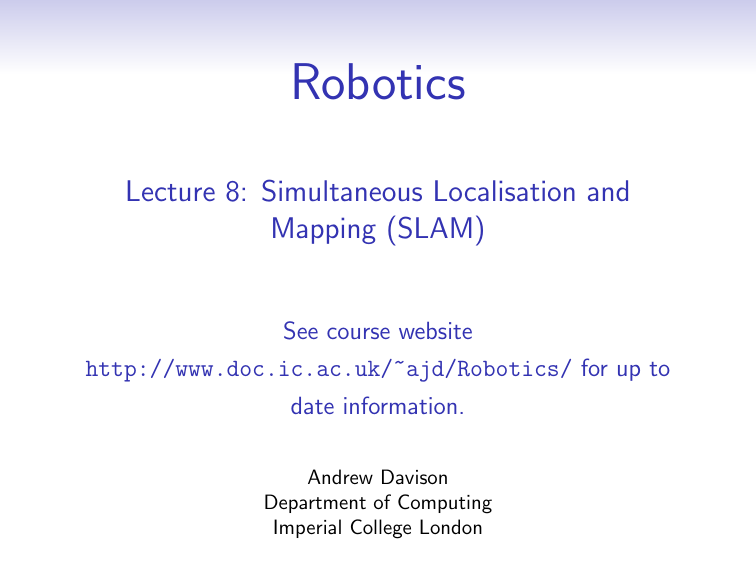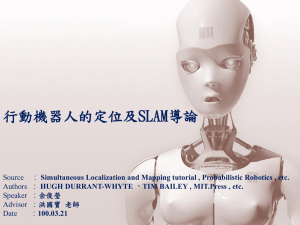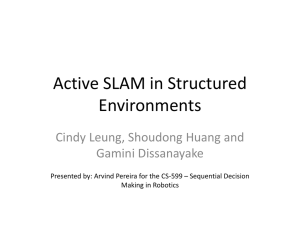Robotics Lecture 8: Simultaneous Localisation and Mapping (SLAM) See course website
advertisement

Robotics Lecture 8: Simultaneous Localisation and Mapping (SLAM) See course website http://www.doc.ic.ac.uk/~ajd/Robotics/ for up to date information. Andrew Davison Department of Computing Imperial College London Review: Practical 7 Location 1 Location 3 Location 2 Location 4 Location 5 Location 6 • Need repeatable spin and measurement. • Recognising orientation too will be computationally costly without invariant descriptors. Simultaneous Localisation and Mapping • One of the big successes of probabilistic robotics. A body with quantitative sensors moves through a previously unknown, static environment, mapping it and calculating its egomotion. • When do we need SLAM? • When a robot must be truly autonomous (no human input). • When nothing is known in advance about the environment. • When we can’t place beacons (or even use GPS like indoors or underwater). • And when the robot actually needs to know where it is. Features for SLAM • Most SLAM algorithms make maps of natural scene features. • Laser/sonar: line segments, 3D planes, corners, etc. • Vision: salient point features, lines, textured surfaces. • Features should be distinctive; recognisable from different viewpoints (data association). Propagating Uncertainty • SLAM seems like a chicken and egg problem — but we can make progress if we assume the robot is the only thing that moves. • Main assumption: the world is static. Simultaneous Localisation and Mapping B C A (a) Robot start (zero uncertainty); first measurement of feature A. Simultaneous Localisation and Mapping (b) Robot drives forwards (uncertainty grows). Simultaneous Localisation and Mapping (c) Robot makes first measurements of B and C. Simultaneous Localisation and Mapping (d) Robot drives back towards start (uncertainty grows more) Simultaneous Localisation and Mapping (e) Robot re-measures A; loop closure! Uncertainty shrinks. Simultaneous Localisation and Mapping (f) Robot re-measures B; note that uncertainty of C also shrinks. Simultaneous Localisation and Mapping • First Order Uncertainty Propagation x̂ = x̂v ŷ1 ŷ2 .. . , P= Pxx Py1 x Py2 x .. . Pxy1 Py1 y1 Py2 y1 .. . Pxy2 Py1 y2 Py2 y2 .. . ... ... ... • xv is robot state, e.g. (x, y , θ) in 2D; yi is feature state, e.g. (X , Y ) in 2D. • PDF over robot and map parameters is modelled as a single multi-variate Gaussian and we can use the Extended Kalman Filter. • PDF represented with state vector and covariance matrix. SLAM Using Active Vision • Stereo active vision; 3-wheel robot base. • Automatic fixated active mapping and measurement of arbitrary scene features. • Sparse mapping. Limits of Metric SLAM z z 1 0 x x Purely metric probabilistic SLAM is limited to small domains due to: • Poor computational scaling of probabilistic filters. • Growth in uncertainty at large distances from map origin makes representation of uncertainty inaccurate. • Data Association (matching features) gets hard at high uncertainty. Large Scale Localisation and Mapping Local Metric Place Recognition Global Optimisation Practical modern solutions to large scale mapping follow a metric/topological approach. They need the following elements: • Local metric mapping to estimate trajectory and possibly make local maps. • Place recognition, to perform ‘loop closure’ or relocalise the robot when lost. • Map optimisation/relaxation to optimise a map when loops are closed. Global Topological: ‘Loop Closure Detection’ • Angeli et al., IEEE Transactions on Robotics 2008. Pure Topological SLAM • Graph-based representation. • Segmentation of the environment into linked distinct places. • Adapted to symbolic planning and navigation. Figure: Topological representation Environment Model • Map defined as a graph of connected locations. • Edges model relationships between locations (e.g. traversability, similarity). Indoor Topological Map Mixed Indoor / Outdoor Topological Map, Several Levels Adding Metric Information on the Edges • Take advantage of odometry measurements from a wheeled robot to add relative displacement information between nodes. • Apply simple graph-relaxation algorithm. to compute accurate 2D absolute positions for the nodes. Relaxation Algorithm 1. Estimate position and variance of node i from each neighboring node j: (xi0 )j = xj + dji cos(θji + θj ) (yi0 )j = yj + dji sin(θji + θj ) (θi0 )j = θj + ϕji(1) (vi0 )j = vj + vji (2) 2. Estimate variance of node i using harmonic mean of estimates from neighbors (ni = number of neighbors of node i): vi = P ni 1 j (vi0 )j (3) 3. Estimate position of node i as the mean of the estimates from its neighbors: 1 X (xi0 )j vi xi = ni j (vi0 )j 1 X (yi0 )j vi yi = ni j (vi0 )j sin((θi0 )j ) (vi0 )j cos((θi0 )j ) j (vi0 )j P θi = arctan P j (4) Relaxation Algorithm (Duckett, 2000): Illustration The position and orientation of node j is obtained as the mean of the positions obtained from nodes i and k (i.e., by composing their positions with the corresponding relative displacements to node j). Map Relaxation: Good Odometry, One Loop Closure Simple Large-Scale SLAM: RATSLAM Milford and Wyeth, 2007. http://www.youtube.com/watch?v=-0XSUi69Yvs • Very simple ‘visual odometry’ gives rough trajectory. • Simple visual place recognition provides many loop closures. • Map relaxation/optimisation to build global map.




